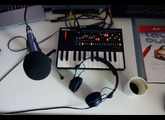« A vintage-spirited vocoder »
Published on 04/25/18 at 05:28
Best value:
Correct
Audience:
Anyone
I’ve invested in a VP-03 to get credible vintage string machine and vocoder sounds, and the VP-03 perfectly fulfills my expectations.
As with all Boutique series products, manufactoring quality is very good.
The lower shell is made of plactic, and the upper part of metal. The switches and faders don’t move unexpectedly and remain in their original axis.
The controls are easy to handle and (unlike with the JP-08 for instance) they’re well adapted to their use, in spite of their small size.
There’s no preset memory, but what use would they be? Regarding the settings, everything here is minimalistic, so no risk to get lost: it’s easy and instantly efficient, not a machine designed for experimenting deeply with sound but it remains an inspiring device to record vocoded vocal inspirations while having fun.
I like the fact that when you turn it on, you find the same settings you were using when you turned it off, so there’s no discrepancy with the knob positions and you easily gat back to where you had left the previous recording session.
In the end, the VP-03 only does three things: a string sound, a human voice sound and a vocoder sound – but it does each of them very well.
-16 patterns can be programmed over 16 steps, and bits of your own voice (or other sources) can also be recorded through USB. It’s fun, and you can leave it to chance to create strange loops, mixing your direct voice with the vocoded voice, the string machine and the human voice.
The 5/6 USB outs allow sending other sound sources (carrier, VST synths…) to the vocoder, and the 3/4 outputs or the mic’s physical input allow to send modulated vocals of speeches, so it’s rather versatile though the lack of an analog audio in is a pity as you can’t send hardware synths through it...
I find its value-for-money to be a little under that of the other Boutique series synths.
So far, i haven’t remarked any MIDI micro-latency.
Pros:
-Well-built
-A convincing vintage-sounding vocoder
-Good and fun-to-use ergonomics.
-16 chord memory banks which are very useful.
-The last settings used are kept when turned on again.
-Credible and inspiring vintage sounds.
-The Ensemble effect is well-modelled.
-Stereo 24/96kHz audio interface
-USB power supply
-Battery-supplied for a complete autonomous use
-Possibility to send other audio sources to the vocoder through USB
Cons:
-No audio in like on the first three Boutique models.
-Audio out volume lower than on the three previous Boutique models.
-The original microphone is very sensitive to all kinds of unwanted noises (breath, pop, keyboard noises…).
-A slight audio buzz when plugged on the computer’s USB, like all other Boutique models.
-Value-for-money is not as good as the 3 first Boutique synths.
-Polyphonics is a beat subpar compared with a real string machine.
-No plug for a sustain pedal, which would have been useful for such kinds of sounds.
As with all Boutique series products, manufactoring quality is very good.
The lower shell is made of plactic, and the upper part of metal. The switches and faders don’t move unexpectedly and remain in their original axis.
The controls are easy to handle and (unlike with the JP-08 for instance) they’re well adapted to their use, in spite of their small size.
There’s no preset memory, but what use would they be? Regarding the settings, everything here is minimalistic, so no risk to get lost: it’s easy and instantly efficient, not a machine designed for experimenting deeply with sound but it remains an inspiring device to record vocoded vocal inspirations while having fun.
I like the fact that when you turn it on, you find the same settings you were using when you turned it off, so there’s no discrepancy with the knob positions and you easily gat back to where you had left the previous recording session.
In the end, the VP-03 only does three things: a string sound, a human voice sound and a vocoder sound – but it does each of them very well.
-16 patterns can be programmed over 16 steps, and bits of your own voice (or other sources) can also be recorded through USB. It’s fun, and you can leave it to chance to create strange loops, mixing your direct voice with the vocoded voice, the string machine and the human voice.
The 5/6 USB outs allow sending other sound sources (carrier, VST synths…) to the vocoder, and the 3/4 outputs or the mic’s physical input allow to send modulated vocals of speeches, so it’s rather versatile though the lack of an analog audio in is a pity as you can’t send hardware synths through it...
I find its value-for-money to be a little under that of the other Boutique series synths.
So far, i haven’t remarked any MIDI micro-latency.
Pros:
-Well-built
-A convincing vintage-sounding vocoder
-Good and fun-to-use ergonomics.
-16 chord memory banks which are very useful.
-The last settings used are kept when turned on again.
-Credible and inspiring vintage sounds.
-The Ensemble effect is well-modelled.
-Stereo 24/96kHz audio interface
-USB power supply
-Battery-supplied for a complete autonomous use
-Possibility to send other audio sources to the vocoder through USB
Cons:
-No audio in like on the first three Boutique models.
-Audio out volume lower than on the three previous Boutique models.
-The original microphone is very sensitive to all kinds of unwanted noises (breath, pop, keyboard noises…).
-A slight audio buzz when plugged on the computer’s USB, like all other Boutique models.
-Value-for-money is not as good as the 3 first Boutique synths.
-Polyphonics is a beat subpar compared with a real string machine.
-No plug for a sustain pedal, which would have been useful for such kinds of sounds.

